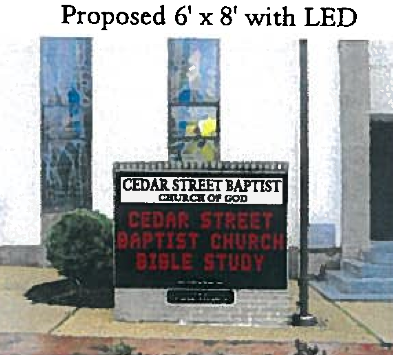RECENT COMMENTS
Eric S. Huffstutler on What is up with the Church Hill Post Office?
Eric S. Huffstutler on What is up with the Church Hill Post Office?
Yvette Cannon on What is up with the Church Hill Post Office?
crd on Power Outage on the Hill

A sign for Cedar Street
09/15/2010 6:20 AM by John M
The CAR Submission Application for Cedar Street’s LED sign (PDF) offers a clear idea of what they are seeking to put in place.






Since I’m on a roll with this historical context stuff, here’s a bit about the significance of Cedar Street’s building and its importance to our community. Built in 1893, the current Cedar Street church building was actually the fourth Union Station Methodist church building built in Union Hill. Union Station Methodist church left the neighborhood in the mid-19th c. and joined with another church to form what is now Reveille United Methodist in the Near West End.
The history of Union Station Methodist Church and its buildings in many ways parallels the development of Union Hill. Around 1835, two young men who were studying for the ministry began to hold services at various locations on Union Hill. The movement gained strength and they secured permission to use the carriage house behind the home of Mrs. William Cullingsworth. Mrs. Cullingsworth resided in the 2400 block of Venable Street where the Hasker-Marcuse factory now stands. The converted carriage house became known as Union Hill Chapel. On 15 November 1843, at a session of the Methodist’s Virginia Annual Conference the church was officially recognized and called Union Station. The congregation continued to grow and in 1844 a lot was purchased on North 25th Street between N (now called Cedar Street) and O streets That building is currently occupied by Mt. Sinai Baptist church and is believed to be the oldest African American church structure in the City.
By 1854, the congregation had swelled to 300 and a lot was purchased for a new building at the corner of 24th and N streets. The 1844 chapel, renamed Asbury Chapel, was turned over to the slaves and free-blacks who had worshiped with the congregation since the founding of the church. The new Union Station building was designed by Samuel Freeman and built by T. Wiley Davis. It was an exceptional distyle-in-muris Temple Revival church that resembled Old First Baptist and Centenary Methodist. Samuel Freeman and his brother, John, were among the city’s earliest builder-architects. The designs of Old First Baptist and Centenary have been attributed to Samuel, as well as several major industrial buildings including the William H. Grant Tobacco Factory and the Yarbrough-Pohlig Factory. T. Wiley Davis, contractor and builder, has been credited with the construction of “some of the largest buildings and costliest structures of the city: Several of the great Richmond tobacco factories, many handsome and costly residences, …and a dozen or more churches.
This looks trashy!
Oh yeah, and the sign looks trashy.
In my opinion, electronic signs should be kept out of city old and historic districts. I’ll agree with the other folks that this sign looks awful.
this guy at the church made a big deal about his support for the old and historic district now he wants a favor.the sign sucks and if he gets his request granted it will certainly demonstrate the hypocrisy and inequity of the new ordinances.but then thats not exactly a secret now is it?buddycorbett
I agree. I think these signs have their place but a historic district (or an area trying to revitalize itself) isn’t one of them.
Agreed. It’s a bit garish.
Where were you all when Vernon J. Harris clinic was petitioning CAR to approve their ridiculous LED sign that cost them $40,000!!!!!! They spent $40k on a stupid sign and they are a nonprofit health care clinic for the poor!!!!!!!!!!WTF???